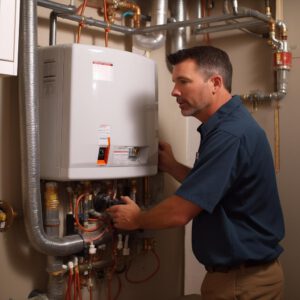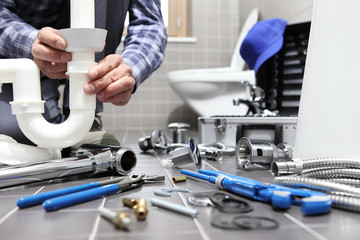If you notice your water heater is leaking or is over 10 years old, it might be time to replace it. Hot Water Heater Replacement Denver is often more cost-efficient than repairing an older tank.

Turn off your gas service and drain the water heater with a hose. Be sure to let the water cool before handling.
When the time comes for your hot water heater to be replaced, you may wish to consider a smart thermostat as part of the upgrade. These devices help save energy by allowing you to program the exact temperature you want in your home. You can also track your energy usage and see what your savings are over time.
When selecting a new thermostat, there are many options to choose from. Some are simple and inexpensive, while others offer a variety of features and are compatible with different heating systems. The best choice for you will depend on the needs and budget of your household.
You should also consider the location of your thermostat. The ideal placement is towards the center of your home, away from doors and windows. It should be at least 52 to 60 inches above the floor for an accurate reading of air temperatures. It is also important to remember that the temperature setting for your thermostat will affect both your heat and air conditioning, so you should keep this in mind when deciding where to place it.
The first step is to shut off the gas to your current water heater. It is also a good idea to drain the existing tank. Then you can disconnect the water lines and remove the old heater. You will probably need assistance with the removal and a dolly of some kind to move it. Once the old unit is removed, you will need to install the new one.
It is a good idea to consult the manual for your hot water heater when doing this, as some models require special tools or additional steps. Then you will need to connect the new gas line to your water heater and connect the new thermocouple and gas control valve. It is important to make sure you have the correct size tubing for the line and the right pressure and temperature.
If you are replacing a gas water heater, it is also a good idea to replace the anode rod. This is an important safety device that helps prevent corrosion and extends the life of the unit. While you can do this yourself, it is a job that is often better left to professional plumbers.
Water Heater Tank
The water heater tank is the innermost layer of your hot water system. It’s a heavy metal tank with a protective liner that holds 40 to 60 gallons of hot water at 50 to 100 pounds per square inch (PSI). Over the tank, there’s usually an insulating blanket and an outer shell.
Water enters the tank through a dip tube at the bottom and a heating burner or element heats it. As the water heats, it rises and is drawn off through a faucet for use. There’s a thermostat to monitor the temperature and a pressure relief valve to prevent overheating.
You can buy a new water heater from just about any large hardware store or plumbing/heating company. They can help you determine the right size and type of heater for your needs and install it. Some companies even offer a free estimate and advice before you buy.
It’s important to choose a tank that’s the right size for your household. A larger tank costs more than a smaller one, but it will save you money on energy bills. To make sure you have enough capacity, estimate the peak hourly usage for your home. This is typically in the morning when everyone gets up to shower, but it could also be in the evening when your family draws long hot baths and runs a dishwasher.
An anode rod is a metal rod that’s installed in the tank to protect the inside walls of the tank from rust and corrosion. This is an essential part of your water heater and if it breaks down, you’ll notice that your hot water has a rusty taste or smell.
If your water is rusty-colored or gritty, it’s often because of sediment that has built up inside the tank. You can often fix this problem by having the tank flushed, but if it’s time for a replacement, consider choosing a model that has an anti-scale feature to reduce sediment buildup. These models typically cost a little more, but they can last twice as long as standard tanks.
Vent
Venting is an important component of gas water heaters, just like they are for other appliances that use gas such as furnaces or stoves. Venting exhausts the harmful fumes produced by combustion to the outside, to keep you and your family safe. If the venting system isn’t installed correctly, it can cause carbon monoxide poisoning in your home.
There are a few different ways to vent a gas water heater, including direct vent and power vent. A direct vent water heater draws in air from outside to fuel the combustion process, while a power vent water heater uses a fan to help propel the exhaust out through the vent. A direct vent water heater can be installed in almost any location, while a power vent water heater should only be used where there is adequate ventilation available.
Before attempting to upgrade your water heater, be sure to consult with an experienced professional to determine which type of venting is best for you and your family’s needs. Ventilation of any type of gas appliance is not something to take litely, as it can lead to serious injury and even death.
When installing a new gas water heater, it is best to follow the manufacturer’s installation manual. These are often located online or can be accessed through the unit’s control panel. Be sure to physically examine your existing venting system as well, as this can sometimes reveal major problems in the installation that might otherwise go unnoticed.
For any new installations, be sure that the vent pipe is free from obstructions and is properly seated on the top of the tank. It is also recommended that a vent pipe should run at least 12 inches vertically before the first elbow, as this will allow for proper flow and prevent back-drafting. For safety reasons, never try to use a flexible plastic or copper pipe with a gas water heater, as these can easily pinch or kink, causing a leak that can be deadly. Instead, be sure to install a solid copper or CPVC venting system with the appropriate diameter as per local codes and regulations.
Plumbing
Over time, minerals and sediment build up inside the tank, creating air pockets. When these pockets release, it can cause popping, banging or rumbling noises in your home. These sound indicate that the water heater is reaching the end of its life and may need to be replaced.
Leaks around the water heater are another common sign of a faulty unit. These leaks can soak and damage belongings, and they can also create a breeding ground for mold. A professional plumber can diagnose the problem and determine whether it’s a simple issue like sediment buildup, or something more serious like a crack in the steel liner or defective temperature and pressure relief valve.
The first step in repairing a leaky water heater is to turn off the water supply. This is usually done with a valve located above the water heater on the cold water line. The plumber will also need to shut off the gas or electricity that power the water heater, which requires locating the circuit breaker for the unit and turning it off.
Once the water heater is disconnected, it can be removed from its location. Before attempting to do this, it’s important to know that the old unit can be extremely heavy and dangerous to move. For this reason, it’s a good idea to have assistance available or use a dolly.
After the old water heater is removed, the new one will need to be connected to the existing pipes and the gas or electrical connections. It’s very important that these are done by a professional, as faulty hookups can lead to serious injury or property damage.
Some areas require a gas water heater to be vented through a special double-chambered vent pipe. This type of venting system prevents exhaust gases from being drawn into the home, and it may also be required in modern air-tight homes. While DIYers can learn how to make this change, it’s a task best left to professionals with the proper equipment and certification to perform work that complies with local codes.



